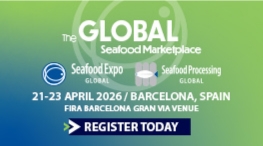26-28 April 2022Seafood Expo Global / Seafood Processing GlobalBarcelona,…
Tag:
global
-
-
According to surveys carried out by the Food and Agriculture Organisation (FAO), the quantities produced by global aquaculture reached an all-time high of 120 million tonnes (live weight) in the year 2019, with a total sale value (ex farm gate) of 274.6 billion US dollars. Of this, 85.3 million tonnes were accounted for by animals (USD 259.5 billion), 34.7 million tonnes by algae and aquatic plants (USD 14.8 billion) and 26,841 tonnes by ornamental shellfish and pearls (USD 228.4 million).
-
Even though fishing activities have been monitored for selected fleets using electronic vessel monitoring systems, logbooks, and onboard observers, these efforts only provide very limited evidence of a region’s fishing patterns. A new study published by Science Magazine has made use of global satellite-based observations along with artificial intelligence to train and analyse the 22 billion messages publicly broadcast from marine vessels’ automatic identification system (AIS) from 2012 to 2016. The particularity of movements relating to fishing have led to the identification of more than 70,000 fishing vessels ranging from 6 to 146 m in length, with a 95% accuracy. The movements of these commercial fishing vessels have been tracked hourly and reveal a global ‘heat map’ that covers more than 55% of the ocean’s surface or over four times the area covered by agriculture. Although the data set includes only a limited proportion of the world’s estimated 2.9 million motorized fishing vessels, it encompasses most of the larger vessels exceeding 24m in length and is estimated to account for between 50 to 70% of the total high seas fishing. Over the course of 2016, the data set captured 40 million hours of fishing activity by these vessels covering a combined distance of more than 460 million km, the equivalent of traveling to the moon and back 600 times, and consuming 19 billion kWh of energy.




